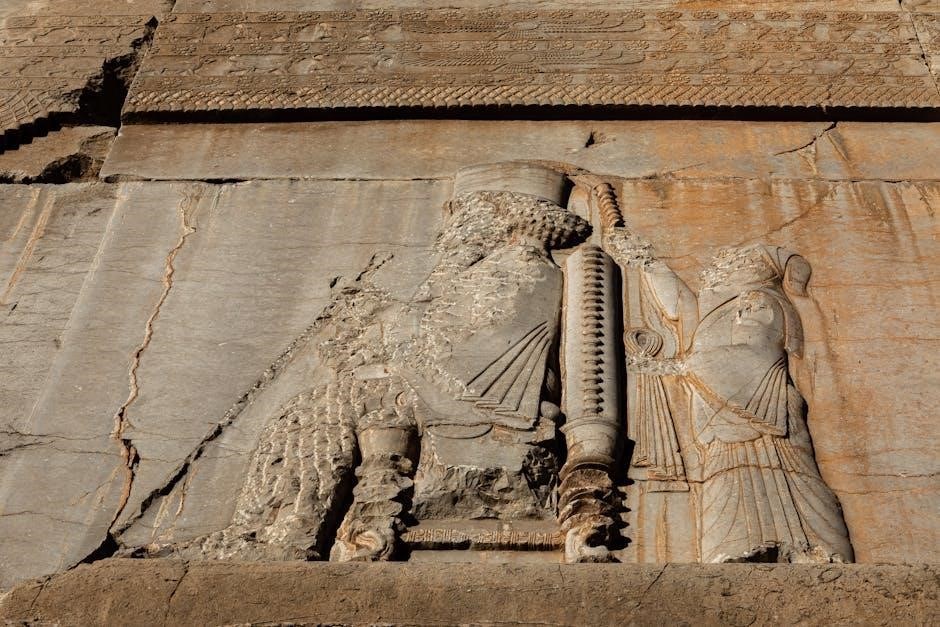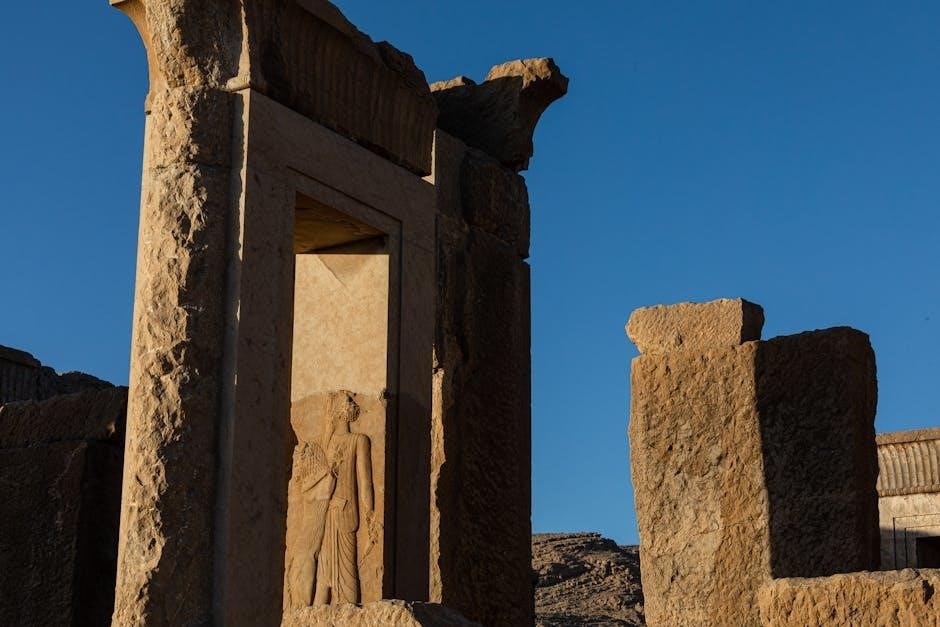“The Complete Persepolis” is a graphic novel by Marjane Satrapi, published by Pantheon Books in 2003. This memoir explores identity, culture, and politics through vivid visuals and storytelling.
1.1 Overview of the Graphic Novel
“The Complete Persepolis” is a graphic memoir by Marjane Satrapi, recounting her childhood in Iran during the Islamic Revolution and her later years in Europe; The novel explores themes of identity, culture, and political upheaval. Satrapi’s unique storytelling blends personal narrative with historical context, offering a deeply human perspective on Iran’s turbulent history. The graphic novel’s simple yet powerful artwork, rendered in black-and-white, complements its emotional depth. It has become a landmark work in contemporary literature, resonating with readers worldwide for its universal themes of belonging and self-discovery.
1.2 Importance of the Complete Edition
The complete edition of “The Complete Persepolis” offers a cohesive narrative, combining both volumes of Marjane Satrapi’s graphic memoir. This edition provides readers with an uninterrupted journey through her life, from childhood in Iran to adolescence in Europe. By presenting the story in its entirety, the complete edition underscores the thematic continuity and emotional depth of Satrapi’s work. It also highlights the universal themes of identity, culture, and belonging, making it an essential read for understanding the author’s vision. The complete edition is particularly valued for its unbroken narrative flow and comprehensive insight into Satrapi’s experiences.
Historical Context of Persepolis
The story is set against the backdrop of the Iranian Revolution and its aftermath, exploring Marjane’s experiences growing up in Tehran during a time of cultural and political upheaval.
2.1 Ancient Persepolis and Its Significance
Ancient Persepolis, the ceremonial capital of the Achaemenid Empire, was founded by Darius I in the 6th century BCE. It symbolized Persian power and cultural achievement, featuring grand architecture like the Apadana and the Gate of All Nations. These structures showcased Persian artistry and the empire’s vast influence. Persepolis served as a center for cultural exchange, reflecting the empire’s diversity. Its historical significance lies in its role as a testament to the Achaemenid Empire’s achievements. The site’s destruction by Alexander the Great in 330 BCE marked the end of an era, leaving behind a legacy of architectural and cultural brilliance.
2.2 Modern Persepolis in the Context of Iranian History
Modern Persepolis, though in ruins, holds profound symbolic significance in Iranian history. It represents the nation’s resilience and cultural pride, enduring despite centuries of conquest and destruction. The site serves as a reminder of Iran’s ancient glory and its role in shaping global heritage. Today, Persepolis is a source of inspiration for artists, writers, and historians, connecting modern Iranians to their rich past. Its legacy continues to influence contemporary Iranian identity, bridging the gap between ancient traditions and modern aspirations, making it a cornerstone of national pride and historical consciousness.

Author Background: Marjane Satrapi
Born in Rasht, Iran in 1969, Marjane Satrapi grew up during the Iranian Revolution, shaping her unique perspective on identity, culture, and politics through her graphic novels.
3.1 Early Life and Influences
Marjane Satrapi was born in 1969 in Rasht, Iran, to a progressive family. Her early life in Tehran exposed her to the contrasts of modernity and tradition. Her grandfather, a former mayor, shared stories of Iranian history, sparking her political awareness. Satrapi’s upbringing during the Iranian Revolution deeply influenced her worldview. She attended school in Austria, where she faced cultural isolation, fostering her identity struggles. Returning to Iran, she witnessed the Islamic regime’s rise, shaping her critique of societal norms. Her passion for art and literature led her to France, where she developed her graphic novel style, blending Iranian heritage with Western enlightenment ideals.
3.2 Motivation for Writing Persepolis
Marjane Satrapi was driven to write “Persepolis” to share her unique perspective on growing up during the Iranian Revolution. She sought to humanize Iran, countering Western stereotypes and offering an intimate look at life under the regime. Her motivation stemmed from a desire to bridge her Iranian heritage with her Western experiences, creating a universal story of identity and belonging. Through her graphic novel, Satrapi aimed to challenge political narratives and provide a personal, emotional account of her journey, blending history with individual struggle to resonate with readers globally.
Narrative Structure and Style
Marjane Satrapi’s “The Complete Persepolis” employs a non-linear narrative, blending memories of her childhood with historical context. The graphic novel’s autobiographical style uses simple, expressive artwork to convey deep emotional and political themes effectively.
4.1 Storytelling Approach
Marjane Satrapi’s storytelling in “The Complete Persepolis” is deeply personal and introspective, weaving her childhood experiences in Iran with broader historical events. The narrative seamlessly transitions between her internal struggles and the external political turmoil, creating a relatable and engaging flow. Satrapi uses a non-linear structure, often jumping between past and present, to emphasize key moments of growth and realization. This approach allows readers to connect emotionally with her journey while understanding the cultural and political context that shaped her life;
4.2 Artistic and Visual Elements
Marjane Satrapi’s artwork in “The Complete Persepolis” is strikingly minimalist, yet deeply evocative. The black-and-white panels create a stark contrast, mirroring the duality of her experiences. Her use of simple yet expressive imagery allows complex themes to resonate powerfully. The visual storytelling is both intimate and universal, with recurring motifs like veils, eyes, and hands symbolizing identity, oppression, and resilience. Satrapi’s consistent character designs and panel layouts ensure a cohesive narrative flow, while her ability to convey emotion through minimal detail enhances the emotional depth of her story, making the graphic novel a visually compelling and unforgettable experience.

Themes and Symbolism
“The Complete Persepolis” explores themes of identity, cultural heritage, and political oppression, using symbolism to convey resilience and freedom. Satrapi’s work masterfully blends personal and universal struggles.
5.1 Identity and Cultural Struggles
Marjane Satrapi’s “The Complete Persepolis” delves deeply into themes of identity and cultural struggles, tracing her journey as an Iranian exile navigating Western and Eastern worlds. Her experiences in Austria and Iran highlight the tension between embracing her heritage and assimilating into foreign cultures. The graphic novel vividly portrays her internal conflict, oscillating between pride in her Persian roots and the allure of Western freedoms. Through her storytelling, Satrapi explores the universal struggle of finding one’s place amidst conflicting cultural expectations, making her narrative both deeply personal and universally relatable. This duality underscores the complexity of identity formation in a globalized world.
5.2 Political and Social Themes
“The Complete Persepolis” tackles profound political and social themes, offering a poignant critique of the Iranian Revolution and its aftermath. Marjane Satrapi vividly portrays the rise of religious fundamentalism, the suppression of dissent, and the impact of war on society. The graphic novel also explores gender roles, censorship, and the clash between tradition and modernity. Through her personal journey, Satrapi examines the human cost of political upheaval, shedding light on the complexities of identity, freedom, and belonging in a socially restrictive environment. Her narrative bridges the gap between the personal and the political, resonating universally.

Reception and Impact
“The Complete Persepolis” received widespread critical acclaim for its raw storytelling and cultural insight. It has won numerous awards and sparked debates, solidifying its literary significance.

6.1 Critical Acclaim and Awards
Marjane Satrapi’s “The Complete Persepolis” has garnered widespread critical acclaim for its poignant storytelling and cultural depth. The graphic novel won the Cannes Festival Prize and received an Academy Award nomination for the film adaptation. It has been translated into numerous languages, resonating globally. Critics praise its raw honesty and visual artistry, making it a landmark in graphic literature. The book has also been included in educational curriculums worldwide, highlighting its educational value. Its enduring popularity and influence have solidified its place as a modern classic, celebrated for its universal themes and intimate portrayal of identity.
6.2 Controversies and Challenges
“The Complete Persepolis” has faced censorship and challenges globally due to its candid portrayal of Iranian politics, religion, and cultural identity. In 2013, Chicago schools temporarily banned the book over concerns about violence and offensive language. Similar controversies arose in other regions, with critics accusing the work of being anti-Islamic or politically biased. Despite these challenges, the book has received support from free speech advocates, emphasizing its importance in fostering dialogue about censorship and cultural understanding. The graphic novel’s honest depiction of historical events has also sparked debates about representation and authenticity in storytelling.
“The Complete Persepolis” leaves a lasting impression, blending personal and historical narratives with emotional depth; It bridges cultural divides, inspiring reflection on identity, freedom, and resilience. A timeless classic.
7.1 Legacy of Persepolis
“The Complete Persepolis” has left an indelible mark on literature and film, inspiring countless readers and creators. Its raw, personal narrative has redefined how stories about identity, culture, and politics are told. By sharing her journey, Marjane Satrapi has humanized Iran and its people, breaking stereotypes and fostering empathy. The graphic novel’s influence extends beyond its pages, sparking conversations about freedom, identity, and resilience. Its legacy lies in its ability to bridge cultural divides, making it a timeless and universal story that continues to resonate with readers worldwide. A true cultural landmark, “Persepolis” challenges perceptions and inspires understanding.
7.2 Final Thoughts on the Complete Edition
The complete edition of “Persepolis” offers a seamless and immersive experience, weaving Marjane Satrapi’s journey into a unified narrative. It captures the essence of her life, blending personal and political struggles with vivid storytelling. This edition is a testament to Satrapi’s artistry, providing readers with a deeper understanding of her world. Its emotional depth and cultural insights make it a powerful read, timeless in its relevance. For both longtime fans and new readers, “The Complete Persepolis” is a must-have, serving as a poignant reminder of identity, resilience, and the human experience. A true literary treasure.



